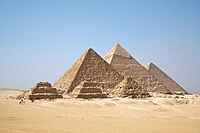
Back مهد الحضارة Arabic Trubiecu de la civilización AST Sivilizasiyanın beşiyi Azerbaijani Калыска цывілізацыі Byelorussian সভ্যতার সূতিকাগার Bengali/Bangla Bressol de la civilització Catalan Kolébka civilizace Czech Civilisationens vugge Danish Lulilo de Civilizacio Esperanto Cuna de la civilización Spanish
| Part of a series on |
| Human history and prehistory |
|---|
| ↑ before Homo (Pliocene epoch) |
| ↓ Future (Holocene epoch) |
| Ancient history |
|---|
| Preceded by prehistory |
|

A cradle of civilization is a location and a culture where civilization was developed independent of other civilizations in other locations. A civilization is any complex society characterized by the development of the state, social stratification, urbanization, and symbolic systems of communication beyond signed or spoken languages (namely, writing systems and graphic arts).[1][2][3][4][5]
Scholars generally acknowledge six cradles of civilization: Mesopotamia, Ancient Egypt, Ancient India and Ancient China are believed to be the earliest in Afro-Eurasia (previously called the Old World),[6][7] while the Caral-Supe civilization of coastal Peru and the Olmec civilization of Mexico are believed to be the earliest in the Americas - previously known in Western literature as the New World. All of the cradles of civilization depended upon agriculture for sustenance (except possibly Caral-Supe which may have depended initially on marine resources). All depended upon farmers producing an agricultural surplus to support the centralized government, political leaders, religious leaders, and public works of the urban centers of the early civilizations.
Less formally, the term "cradle of civilization" is often used to refer to other historic ancient civilizations, such as Greece or Rome, which have both been called the "cradle of Western civilization".
- ^ Haviland, William; et al. (2013). Cultural Anthropology: The Human Challenge. Cengage Learning. p. 250. ISBN 978-1-285-67530-5. Archived from the original on 13 July 2019. Retrieved 20 June 2015.
- ^ Fernández-Armesto, Felipe (2001). Civilizations: Culture, Ambition, and the Transformation of Nature. Simon & Schuster. ISBN 978-0-7432-1650-0. Archived from the original on 1 April 2021. Retrieved 20 June 2015.
- ^ Boyden, Stephen Vickers (2004). The Biology of Civilisation. UNSW Press. pp. 7–8. ISBN 978-0-86840-766-1. Archived from the original on 30 December 2016. Retrieved 20 June 2015.
- ^ Solms-Laubach, Franz (2007). Nietzsche and Early German and Austrian Sociology. Walter de Gruyter. pp. 115, 117, 212. ISBN 978-3-11-018109-8. Archived from the original on 30 December 2016. Retrieved 20 June 2015.
- ^ AbdelRahim, Layla (2015). Children's literature, domestication and social foundation: Narratives of civilization and wilderness. New York: Routledge. p. 8. ISBN 978-0-415-66110-2. OCLC 897810261.
- ^ Charles Keith Maisels (1993). The Near East: Archaeology in the "Cradle of Civilization. Routledge. ISBN 978-0-415-04742-5. Archived from the original on 18 April 2023. Retrieved 10 November 2020.
- ^ Cradles of Civilization-China: Ancient Culture, Modern Land, Robert E. Murowchick, gen. ed. Norman: University of Oklahoma Press, 1994
© MMXXIII Rich X Search. We shall prevail. All rights reserved. Rich X Search